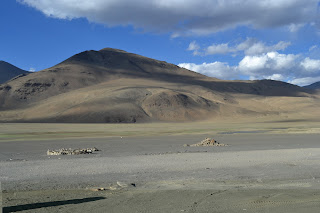 |
| Our neighborhood |
Though vastly improved over the past ten years, safe to say, it is not the easiest of roads. What starts out as a casual ride through the hills, more often than not leads onto paths of wonder, tests of limitations, and labyrinths of introspection and self-knowledge. Confronted along the road with the majesty of the Himalayan peaks, the shear bitterness of the arid winds, the deprivations of high altitudes and the horizon-less vistas, one is forced to lighten up, detach ones anchors, dissolve the old versions and aversions, and fall back on the essence of things.
 |
| The bare vastness and the colors |
Eventually, the road arrives at my destination. Nestled in the middle of nowhere, suspended like an island 5000 m above the surface of everyday life, and protected by some of the highest passes in the world is the vast Chanthang Plateau, the nomadic center of India's meager pashmina production. Which in my experience is the best cashmere available today.
 |
| Pitching the tent |
Cashmere really is the softest, warmest and finest of all fibers. Yet, who would know that, when guided by 'price' and 'label' alone we buy and the producers flood the market with cheap imitations and blends. Pashmina has become a bit of joke among kashmiri shop owners, as well as western designers and retailers selling silks, mohair, angora, acrylics, merino blends and marketing schemes, such as the so called 'water pashminas' from Nepal under the name of cashmere. On the other hand, our ignorance and inability to distinguish the real thing from the imitations serves as a sad testament of how we have grown detached from nature that surrounds us.
 |
| One of our handspun pashmina scarfs |
Might be a good place for a link to our Etsy store
Most of the cashmere in production today comes from China and Mongolia and before it arrives in the hands of the customer it passes through numerous cleaning, dehairing, carding, blending and spinning processes, loosing a piece of itself and gaining lots of fat along the way. Same is true of the Ladakhi pashmina which makes its stops in the mills of Srinagar and Ludiana, with the same final effect, of becoming a shadow of its former self.
Most of the cashmere in production today comes from China and Mongolia and before it arrives in the hands of the customer it passes through numerous cleaning, dehairing, carding, blending and spinning processes, loosing a piece of itself and gaining lots of fat along the way. Same is true of the Ladakhi pashmina which makes its stops in the mills of Srinagar and Ludiana, with the same final effect, of becoming a shadow of its former self.
 |
| Neighbors taking a peek |
The main reason behind all of these shenanigans is the scarcity of the natural product....Like the Koshihikari rice of Japan, the sales exceed the actual production probably by a hundredfold. Since trying to find the real thing in the marketplace is like looking for a needle in the haystack, thanks to my friends from the Chanthang Co-op, I find myself looking for the essence of cashmere at its source, one of the 30 odd nomadic settlements of Chanthang.
 |
| The source |
"Be careful of what you wish for"...so the saying goes. Experiencing the materials we work with at their sources can be a heavy blessing. In each and every case, these adventures of inquiry add a dimension of understanding that was originally lacking. In case of cashmere, it started with a search for purity, which transformed into something richer and more complex, something that calls for commitment and involvement Since our first innocent trip here in 2007 and after each subsequent visit it became more and more apparent that there are many are other layers to consider. There are the nomads and their timeless but hard lifestyle, there is the fragile plateau reacting to a tremendous increase in tourism and the changing environmental conditions, the animals themselves, the lack of water, the historical and political context, the governmental efforts, the pricing structure and probably many other things that my soul is not sensitive enough to perceive.
 |
| As things continue.... |
Let me leave you here with a few pictures of these underlying currents, some individual other universal, with the hope of picking up on some of these threads in future posts....
ORGANIC: in an ironic twist of faith, Ladakhi pashmina does not carry the 'organic' label...
INFRASTRUCTURE
 |
| Pumping water |
THE CHILDREN
 |
| Boy rounding up the does for milking |
 |
| Pashmina playgroud |
NOMADIC LIFESTYLE
 |
| Carrying the heavenly fiber for collection |
 |
| As time stands still |
THE LIVING CONDITIONS : for example, during the warm months these tents go down and the settlements move every 2 weeks in search of new pastures
MILKING THE DOES
MAKING YAK WOOL ROPE
THE CHANGING CLIMATE AND WATER AND PASTURES : these goats and sheep have to traverse 20 to 30 km per day in search of pasture and water
TAKING CARE OF THE SICK
 |
| Sick baby in the comfort of the tent |
THE GOATS : noble stubbornness, what other creature could survive with such grace in such conditions. But on the other hand, the do benefit from a cashmere undercoat, and don't do too well in more habitable environments.
LET'S NOT FORGET THE YAKS
THE FUTURE: let me leave you with this family, they might be a typical nomadic family with two sons, one of which is studying in Leh and dreaming of a career in the army, and the other who refuses to build a house in the city, since it would mean they would have to sell some of their yaks.







































